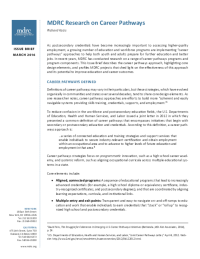MDRC Research on Career Pathways

As postsecondary credentials have become increasingly important to accessing higher-quality employment, a growing number of education and workforce programs are implementing “career pathways” approaches to help both youth and adults prepare for further education and better jobs. In recent years, MDRC has conducted research on a range of career pathways programs and program components. This Issue Brief describes the career pathways approach, highlighting core design elements, and profiles MDRC projects that shed light on the effectiveness of this approach and its potential to improve education and career outcomes.
Definitions of career pathways may vary in their particulars, but these strategies, which have evolved organically in communities and states over several decades, tend to share core design elements:
-
Aligned, connected programs: A sequence of educational programs that lead to increasingly advanced credentials (for example, a high school diploma or equivalency certificate, industry-recognized certificates, and postsecondary degrees), and that are coordinated by aligning learning expectations, curricula, and institutional links.
-
Multiple entry and exit points: Transparent and easy-to-navigate on- and off-ramps to education and work that enable individuals to earn credentials that “stack” or “roll up” to recognized high school and postsecondary credentials.
-
Focus on careers and employer engagement: Targeting high-growth sectors and occupations, encouraging employers to participate in curriculum and program design and instruction, and providing work-based learning experiences.
-
Support services that promote student progress and completion: Academic and other supports for underprepared individuals, including curricular attention to mastering “soft skills,” quality instruction that integrates career or technical skills and academic learning, guidance and peer support for educational and career decisions, and financial aid when necessay.
Career pathways models and approaches look different depending on the target population (for example, high school students, out-of-school youth, or working adults), sector focus (for example, the health care field or manufacturing), the type and location of educational and employer institutions (for example, community colleges, technical schools, employer associations, or workforce development intermediaries), and state policies.
MDRC has studied aspects of career pathways approaches for decades. Research on the Center for Employment and Training model for low-skill adults and on the Career Academies model for in-school youth in the 1980s and 1990s helped shape the development of programs that coherently combine employment and education and lead to credentials and higher income.
Today, MDRC’s research in this area focuses on education and employment programs that target high school students, out-of-school and disconnected youth who lack high school credentials, and low-skill and low-wage adults. It includes implementation and random assignment studies of promising programs and program components and reports on past and current research and practice that present lessons for practitioners and policymakers. Findings from other MDRC projects, such as those on how best to structure financial incentives, case management for low-income youth and adults, and effective teaching practices, might also help designers and managers of career pathways programs.






